Diary Of The Examination Of Barrows And Other Earthworks
Diary Of The Examination Of Barrows And Other Earthworks is in Diary of a Dean by John Merewether.
Jul 1849. Diary Of The Examination Of Barrows And Other Earthworks In The Neighbourhood Of Silbury Hill [Map] And Avebury, Wilts, In July And August 1849 by John Merewether (age 52).
Books, Prehistory, Diary of a Dean by John Merewether, Diary Of The Examination Of Barrows And Other Earthworks, Diary of A Dean Jul 1849
July 18th. Reached the way-side inn, the "Waggon and Horses [Map]," at Beckhampton, in Wiltshire, subsequently yclept by our party the Archæological Hotel; proceeded to inspect tunnel at Silbury Hill [Map], which had then penetrated 30 yards; went to Avebury, after an interval of 30 years; since my last examination missed several stones from thence and from the Kennet Avenue.
19th. This day employed in visits to the tunnel and in obtaining leave to open barrows, successfully and without loss of time, through the aid of Mr. George Brown, and by the kindness of others in the neighbourhood from time to time; made a circuit over the downs east of. Avebury, Bye Hill Down, and Hacpen, to select barrows for examination. The breaking up of the land for tillage made it very difficult to recognise the exact spots where I had formerly opened some, and observed others.
20th. Opened a flat barrow (No. 1) of about 25 yards from skirt to skirt, and 5 feet from the apex to the level of the surrounding down, situated in the centre of the flat down about a mile and a quarter from Avebury, and at half a mile's distance from any other barrow. At the centre, 18 inches below the surface, were the fragments of a coarse unornamented vase, containing the bones of a child which had cut its first teeth, but had not changed them. In the chalk rubble were numerous pieces of deer's ribs. 2 ft. 6 in. from the surface was a skeleton of an adult (A); the thigh-bones measured 14½ inches, the whole frame compressed, tlie right hand turned hack under the wrist, the left laid across the face, and the bones of the wrist and forearm between the upper and lower jaws; the skull fractured into minute portions. The crouched posture of the skeleton, the rudeness of the vase with the hones of the child, the flat form and insulated position of the barrow, assign it to the earliest period of sepulture. The molar teeth were much worn, but were evidently those of a young person.
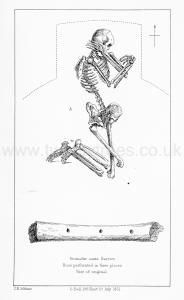
10 Aug 1849 and 11 Aug 1849. No. 2, the first of a range of five large barrows in the rising ground to the north of the last, nearly in a line, a mile and a half north-east of Avebury. These differ in form, 2 and 3 being of the bowl-shape, the others of the more elegant bell-shape, as described by Sir R. C. Hoare in his Ancient Wilts. Although the second and third of this range were not opened until the 10th and 11th of August, I shall describe their produce with the others as belonging to a separate class. After a laborious excavation of the first (No. 2), from the apex to a depth of 10 feet, until we came to the natural chalk through a thin layer, at about 9 feet ,—i e. about the level of the surrounding ground,—of black mould composed of burnt wood, we were obliged to give up the hope of any marked discoveries here. The earth throughout was peculiarly moist, and probably indicated that this barrow had been examined before; there were, however, many fragments of the usual sort of bones and teeth and charred wood.
Books, Prehistory, Diary of a Dean by John Merewether, Diary Of The Examination Of Barrows And Other Earthworks, Diary of A Dean Aug 1849
10 Aug 1849. No. 3 (August 10th). Somewhat smaller in dimensions than the others. Large fragments of bone, teeth, burnt wood; at about 8 feet deep a cist, 18 inches diameter, formed in the natural chalk bed, containing burnt human bones and two small pieces (B) of bronze; (C) a smooth stone tapering towards one end, which had been broken off—it may have been a spear-head, and a rather large flint arrow-head (D), were discovered in the progress of the excavation, as well as a small one of iron (E).
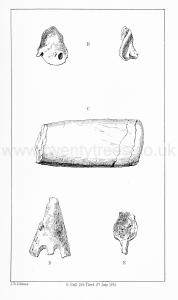
11 Aug 1849. No. 4 (August 11th). At a depth of about 2 ft. 6 in, a considerable fragment of a large coarse urn was found, ornamented with plain hatched lines round the top (F). At the depth of 5 feet, a cist, formed as usual in the chalk, was discovered; this was 2 ft. 6 in. in diameter, the same in depth; it contained in fragments, hut as it had been originally deposited, in the centre, a large plain urn filled with burnt human hones; the urn was 13 inches high (G). The next, a very large barrow, had previously been opened.
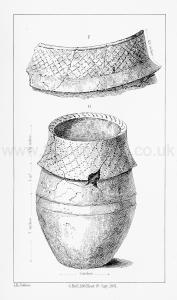
No. 5. This barrow, the last of the five eastward, did not produce in course of its excavation the ordinary quantity of fragments of bone, teeth, or pottery, but was unusually compact and close in its materials; at about 7 feet deep,—the level of the adjacent down,—we came to a cist formed in the natural chalk, filled with burnt human bones, the produce apparently of more than one body. This cist was the largest of those I have met with of this kind; but there was no urn, nor any fragment of pottery, to indicate that the bones had been deposited otherwise than they were found,—they were covered with the black substance like pounded charcoal.
23 Aug 1849. 21st, — Whilst the men were commencing their work at the large barrows on the preceding day, a shepherd stated that one of the boys had told him that he had "hooked" up out of a little barrow on Bye Down Hill a crock, but he knocked it to bits with the stick. On visiting the spot, about a mile north-east, it appeared to be a very small barrow, without any trench round it, and very little elevated; the turf on this part of the down is much broken. At the top of the barrow were evidently the remains of an urn, of a pottery apparently more compact than those recently discovered; and from the holes in the turf, in different directions, various fragments might be collected (H). Almost at the verge of the barrow was a trackway, having a trench on either side; but it was not easy to trace it for more than two miles, in consequence of the cultivation of the hills; it runs nearly east and west; traversing in the easterly direction from this spot the down called "Temple" Down, on which, near its course, is a hut designated by the grandiloquent title of "Glorian."1
Note 1. "Gloria Tanaris." as suggested by the site, as connected with the worship of Mr Bowes, from the possilble sanctity of that deity.
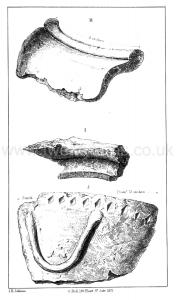
No. 6. This barrow, on being opened, was found to contain at the depth of 2 feet, rather below the level of the surrounding ground, an oval cist formed in the chalk, about 2 feet by H, and 2 feet deep, containing, with burnt human bones, a great quantity of black sooty dust, with which the cist was quite filled up; numerous fragments of bones, teeth of deer, and pottery, were interspersed in the earth forming the nioand. It should not be overlooked, that at about 200 yards to the south of this spot considerable quantities of flints had been dug; these are obtained by taking off sods of turf, and the flints are generally found immediately below the brown or vegetable soil in those places where the vein of flints extends: in this process frequent discoveries are made of skeletons, &c. After the flints are extracted, they are piled up in heaps, and the turf is replaced; in looking over these heaps, a fragment of good Samian ware (I) made its appearance. I think it is remarked by Sir R. C. Hoare, in his Ancient Wilts, that he met with no human remains in connexion with barrows on the north of the London and Bath road, or to the north of Wansdyke; if so, this day's discoveries, which I am about to relate, may be considered to be singularly fortunate. On the brow of this hill, some 100 yards lower , than the barrow just described, and towards the west, are four barrows of considerable size, but of the flat form, except the second, which is a pond barrow. The first of these had evidently been previously opened.

No. 7. I commenced on the pond barrow, by sinking a circular hole of 5 or 6 feet diameter in the centre. The usual indications of fragments of bones of animals, with bits of charcoal and broken pottery, were observable here, but it was clear that no interment had taken place; and it is very difficult to imagine what could have been the intention of this sort of earthwork, on which considerable attention to the exactitude of the circle, the regularity of the surrounding mound, and the dip of the interior space, had manifestly been devoted.
No. 8. The next barrow was one of considerable interest, as on the skirts of it the gentleman who farms this district, Mr. Kemm, had himself found bones and pottery covered over with convex sarsen stones of about 18 inches or 2 feet each in diameter. Fragments of a rude thick pottery were discernible over the surface of the ground, and on opening the centre there appeared four distinct layers of sarsen stones, ranging with the form of the barrow; below which, at the depth of about 3 ft. 6 in., was a circular cist, filled much as that in No. 6, with burnt human bones and the black charcoal dust, but without any urn.
The next barrow (No. 9), the most southern of this group, I had reserved, like the others below, for the examination of some of our friends, whom I hoped to prevail on to return with me from Salisbury; but in order to declare its contents with those to which it belongs, I will describe it here, although it was not opened till the 14th of August. It was of about the same size as the barrow adjoining, but not similarly constructed. Several pieces of thick coarse pottery were exhumed, but not large enough to shew the form or size of the urn to which it belonged; one piece had an unusual embossed pattern upon it (J). At a little more than 2 feet deep, a cist of somewhat irregular form was opened, containing, as in the last, the black charcoal-like substance and burnt bones. A little to the south, below this, the pickaxe struck against a large stone, which, on being uncovered, proved to be a large flat sarsen stone, placed over a cist filled with the same sort of contents; it was about 3 ft. 6 in. from the top of the barrow, and was itself 3 ft. deep, containing, therefore, an unusual quantity of burnt bones.

No. 10. Late in the day, we commenced operations on an insulated flat barrow, not far distant from No. 1; perhaps equidistant from that and No. 5, half a mile eastward. It was of such slight elevation as to be hardly perceptible to any but a practised observer, in the monotonous range of the flat down; but however insignificant in appearance, it disclosed contents of singular interest and rarity. On removing the turf, the quantity of pottery thrown up with the earth was most unusual—all in fragments, with the exception of one portion, which had belonged to an urn of the rude and coarse kind, and of large dimensions, but even this of better texture. All bore evident indications of improvement in manufacture; they were mostly turned on the lathe, and had undergone the process of kiln-baking (K). At a depth not exceeding 18 inches, the fragments of the large vase above mentioned were found, but not in the centre; below them, and covered with flat and somewhat convex sarsen stones, were two very small and shallow cists, containing a few burnt bones. In various parts of the barrow iron nails were collected of very good form; and a little more to the side, in the south-east direction, a small brass Roman coin was discovered. This led to greater vigilance; and its novelty greatly excited the interest of the bystanders of the labouring class, who had on many occasions shewn a disposition to watch our proceedings, under the impression, which in all quarters possesses them — to my cost I know it, in some cases to the destruction of antiquarian treasure—that such excavations are made for the purpose of finding money. I must do my friends of the Avebury district justice in saying, that their quickness of sight in finding these coins, which were mostly detected immediately below the turf, could not be surpassed; whilst they seemed to manifest a pleasure, after a moment's contemplation and examination of the prize, in handing it over to me, with great satisfaction at the increasing number— one of the youths exclaiming, "Well, I'm bless'd if they bain't all as one as though they wur sowed;" for on the whole, after the search of the succeeding Monday, they amounted to no less than 84. On the evening of this day I proceeded to join the congress of the Archaeological Institute at Salisbury. This last barrow was evidently the work of Romano-Britons, who had profited by the instruction in the arts which had been introduced by their fierce but more civilised invaders; and it indicates, what I think others also of earlier age demonstrate, namely, that the same barrow was again and again used for the purposes of sepulture, both by those of the same generation — by whom they may have been regarded as a sort of family burial-places—and by others of subsequent date. My researches in the last three days had been specially successful. I had found instances of the earliest mode of British sepulture, with the crouched and unburnt skeleton, and its rude unbaked urn; then the first indication of a change of custom in this essential particular, mostly the last to be altered,—interment by cremation, derived from the Homan conquerors, whilst the tumulus was retained; and then a still further innovation,—the deposit of all kinds of broken pottery, iron nails (not belonging to any box or cist, for they were dispersed in every part of the barrow), as well as a considerable number of coins, some of which, bearing the image and superscription of Constantine and Constans, carry us down to the middle of the fourth century. Let me add, lest I forget to make the remark, that the conversations I have held with the husbandmen, flint-diggers, and others, whose lives have been mostly spent in agricultural operations on these downs, where they have found numberless skeletons and other remains on the plain downs, and far from any barrows, have led me to this conviction, that the barrows should be considered as the resting-places of the mighty dead,—the chiefs of name, men of renown in their generations; whilst the [greek lettering] the ignobile vulgus, were consigned to mother earth just as they fell, to share at once the oblivion which was but postponed for a brief period to their harrowed chieftains, and in which both chieftain and vassal now so equally participate.
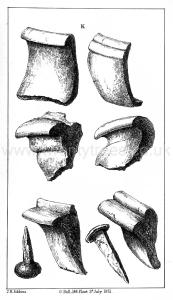
After the Salisbury meeting, a large party started to inspect Silbury Hill and its interesting neighbourhood, on Tuesday, July the 31st; whilst a few, reaching Marlborough the night before, were ready at an early hour to proceed to the spot. These choice spirits I had the honour to conduct to the noble Cromlech [Map] at Clatford (L), and the other objects so worthy of notice en route as already mentioned in a former page. We had ample time not only to examine Silbury, but to lay in, with due regard to the effects of the pure air of these delightful hungrifying hills, an ample preservative from the well-prepared table of the Misses Sloper, at the Waggon and Horses Inn [Map], from this day denominated by us the Archæological Hotel; not forgetting an important article here to be obtained in perfection, and not by possibility to be surpassed either by the metheglin of old, or by the most approved and long-renowned "cerw dha" [Note. Cerw appears to be Welsh for beer?] itself. Our Salisbury friends not having arrived—for they were the sufferers in one of those disasters which seem to be inevitable concomitants in all such expeditions, first or last, their coach having broken down five miles from the end of their journey, thus regaling them with somewhat more of the refreshing breezes and undulatory prospects of the hills and dales of Wilts than they desired—we, more favoured, were constrained to proceed without them to inspect the stupendous remains at Avebury—the area of which within the circular trench and mound, which is on the outside of the trench, contains 28 acres—and to mourn over the fallen and prostrate giants, with the few of their comrades remaining erect, still marking the range of the circles, which once enforced the adoration of a nation, as it is impossible even now that they should not impart to the beholder sentiments of veneration. A melancholy admiration of the zeal even of erring and uncivilised barbarians—a zeal, which could combine the physical force of a whole people to raise such a temple, is surely permissible in this place; whilst our own feelings of gratitude for the mercies of a sure revelation, and the privileges of a pure faith, can hardly be divested of a blush at the contemplation of such advantages as we enjoy, yet of which our zeal for the appropriate temples of the known God, the Most High, does not bespeak us always equally, much less adequately, sensible!
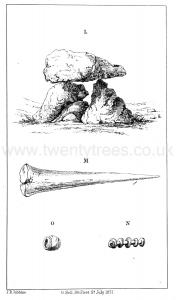
It may be deemed no unprofitable appropriation of our space and time, to give a brief statement of the number of stones originally composing this magnificent temple, what Dr. Stukeley observed, and what we have found there.
The original outer circle was formed of 100 stones; within this were two smaller circles [Avebury North Circle and Avebury South Circle], not concentric, of (each) 30 stones; within each of these a smaller concentric circle, each of 12 stones; in the centre of the northern inner circle were 3 stones [Map]; in the centre of the southern inner circle 1 stone [Map].
Besides these, each avenue was composed of 200 stones, terminating towards the east on Hacpen Hill, in a double oval, the outer containing 40 stones, the inner 18 stones; in the western range were 2 extra stones about half way, forming as it were a recess; and 1 at the termination.
Dr. Stukeley intimates that, in 1723, of the great outer circle there were only 18 stones erect; prostrate 21; including 3 broken off at the ground. Of the northern circle 3 erect, 9 prostrate; of the inner circle, 2 erect, 5 prostrate; in the cove, or centre, 2 erect; of the southern circle 4 erect, 9 prostrate; of the inner circle 1 erect; in the centre none.
Dr. Stukeley adds, that the hollows in the ground, where many of the stones had stood were visible; as is still the case in some instances of more recent removal.
The number of stones in the outer circle at present erect is 7, prostrate 5; of one or two of these the stumps only remain, the rest having been broken off. Of the stones of the southern circle 2 only remain erect, 3 prostrate; none of its inner circle. Of the stones of the northern circle 3 remain erect, 1 prostrate; of its inner circle 2 prostrate; of the central cove [Map] 2 erect, and these are the tallest of all.
The stones in the avenues are sadly diminished in number, even since I first saw them; especially towards Kennett, the most perfect part; and I think there may be in all about 9 or 10 still standing, so scattered as to give the original curve of its course. In the western avenue there are only the two extra stones standing, which I have already mentioned. It is some comfort to know that the present owner of the circle and the western avenue, Mr. George Brown, will not allow a single stone to be defaced or removed; and he has been the means, in time past also, of preserving them. The visit of the Archæeologists in 1849 has contributed not a little to increase the feeling of regard for these venerable relics; a spirit of conservatism has been instilled into the breasts of all, and, what is not a little important, of the young, those in particular who will eventually have the power of guarding these antiquarian treasures. The Christian temple, standing close upon the mound of the ancient Heathen fane, was not deprived of the investigation and approval it deserves. Its exterior appearance gives it a much more modern rank than it claims in reality; its tower, aisles, and chancel, are late decorated; the doorway in the porch is Norman, of extremely good character; and the porch is very remarkable for its early character in the same style. The piers and arches, till within a few years, were also Norman, and portions of the shafts and capitals still project from the eastern and western walls; these arches were taken out, and loftier piers, with pointed arches, introduced, in order to obtain more light. There is the front of a very beautiful rood-loft elevated above the chancel arch, retaining its colouring and gilding. By this time the Salisbury party had happily joined us, and an adjournment to the Downs was speedily effected, where preparations were made to diversify the interest of the party by the examination of a barrow. That chosen. No. 11, was situated in the same plain as that already described as No. 1; but about half or three quarters of a mile more to the south, and at the foot of the range of the Haepen Hill. This barrow was, although small in size, of the more elevated character, and of the second period; it afforded, in the course of excavation, pieces of charcoal, teeth, and fragments of bones and pottery; and at about 3 feet the workmen came to the top of a cist, formed as others in the chalk, and filled with burnt human bones. In the middle of these was the leg-bone of some small animal formed into a sort of pin, very pointed at the one end, and at the other retaining the form of the joint; it bore a high polish (M). Immediately above, on the brow of the hill, was No. 12, a double barrow, which some of the men pronounced to be very promising, as it always sounded hollow as they passed over it; it did not, however, fall to our lot, unfortunately, to hit upon the right place. The usual sort of fragments were not wanting; but I strongly suspect that Dr. Stukeley or Sir Richard Colt Hoare, (in whose presence the first barrow I ever saw opened produced a beautiful early British vase,) could have given some account of this; and hence the hollow sound. I must not omit to record that on this day we dined — i.e. the small party—at Avebury House, in the refectory of a Benedictine Priory, to meet the owner of Silbury Hill, Mr. Jones, and his young sons: to his tenant, Mr. Kemm, and his mother, our hostess this day, we are indebted for their kindness.

01 Aug 1849. Aug. 1st. The next day was to witness the assemblage of the neighbourhood to inspect Silbury; and this very picturesque event I have already described in the former paper. Our party occupied the morning, till the time of repairing to Silbury, in visiting the barrows lying near Beckhampton, between the Caine and Devizes roads. In some of these, very curious urns and remains had been discovered, some of which I shall describe hereafter; but most appeared to have been disturbed. One high up on the hill in the northern direction was examined, but without success. It would be an indication of ungrateful disrespect —for it could not he forgetfulness —were I to omit, though briefly, to record the employment of the evening of this day, and the route we took; albeit it were well to start somewhat earlier than we did, specially if so splendid a moon as conducted us home might not be reckoned upon. But then, as we had been very fully occupied during the day, some regard was needful to he had toward such discoveries as we might be able to make at the Archæological Hotel, calculated to recruit our exhausted strength, which being satisfactorily accomplished, we proceeded with a very docile pair of horses and driver, both desiderata in such an expedition, first to Oldbury Castle [Map], a splendid position, overlooking the rich vale of Caine, Chippenham, Christian Malford, and Malmsbury, and bearing in its entrenchments the characteristics of Roman occupation, enlarged possibly at some time on the south-west side, but very possibly having been previously a British position, and even subsequently occupied by later warriors. I possess an iron spear-head, and one of those curious circular stones with a hole in the centre, found here. Thence we cut across the down towards the Roman road, the Via Badonica leading from Cunetio [Map] to Aquæ-solis [Map], and which, on arriving at Silbury Hill, which it would otherwise have cut at one-third of its base, deflects its course. We cannot boast that any of the dii deœque minors much less Diana herself, Bivia, Trivia, or whatever she might here have been called of old, were very propitious to us; though, in truth, she made ample amende by her bright guidance, when it was subsequently so much needed. The devotees of Ceres had strangely cut up this ancient road; so that, to traverse it with its full complement was not so easy a matter, either to the wheels of our vehicle, to the poor animals who had to draw it, or, indeed, to its occupants; to say nothing of the conductor. So that we traced the ancient way on foot, and were ready, not unneeded, to replace in its vertical position our tottering and almost subverted equipage, at a spot where the descent to Calston below would have been facile enough per saltum, or per volutationem, for the road in this part runs on the very edge of the abrupt and steep precipice of the hill. After some time spent in these corrective and directive pursuits, having fairly landed the really patient driver on the turf, to seek in advance the summit of the hill, we again became viatores in the strict sense of the word, and in its cognate road, until we reached its junction with the famous Wansdyke, the high vallum of which, in most places from 30 to 40 ft. high, is here and for a considerable distance cut down to fill up the foss and form the road. From this point our explorations were by moonlight, bright as day; we had every reason to be grateful for the propitious aid; by it we traced the some what sinuous range of the Wansdyke; I marked, after thirty years' absence, a barrow almost on its bank, which I had meis manibus excavated some 7 or 8 ft. in depth, finding one solitary glass bead (N), which I still possess. The Wansdyke, ere it makes its turn to the right by Shepherd's shore, forms, without any apparent reason, two right angles; and its trench at this point is very deep, and its vallum marvellously high and steep. From hence we were reluctantly obliged, having succeeded in finding our equipage, to return towards Silbury. Some of our party (and one was a lady, precious as an Archmologist and deserving of all our consideration, as well as her excellent brother) had to return the same night to Marlborough. The plain over which we travelled possesses some earthworks worthy of inspection, especially one enclosing, with an approaching avenue to it, some curious barrows. Towards the right Wansdyke boldly ascends the downs to Tan Hill; some say St. Ann's, others the Hill of Tanaris. The whole of this range is replete with exceeding interest, and Madlv should I be the conductor once more of the whole Archæological Institute amidst its varied treasures.

02 Aug 1849. Aug. 2d. By the permission of Mr. George Brown, the scene of our operations this day was Windmill Hill, a large conical eminence rising from the lower ground, on which, on the south-east, stands Avebury, on the north-east Monkton, and on the west Yatesbury. Of Monkton I may take leave to mention, that it possessed, not many years ago, a fine cromlech [Map], now totally gone; and also a long barrow [Map], much resembling the three I shall presently describe. This has been levelled. I saw the man who was employed in the profanation. It contained, he said, "a sort of room built up wi' big sarsens put together like, as well as a mason could set them; in the room was a sight of black stuff, and it did smell nation bad." The name by which this was known was King's Mill Barrow [Map]. Of Yatesbury we shall have to say somewhat anon.
The apex of Windmill Hill is surrounded by a slight and single foss, in diameter — for it is almost an exact circle about 150 yards. Within this, at the south-east, are two large harrows; one has evidently been reduced for agricultural purposes; and I have since learned that in it were found seven skeletons, and a very beautiful little grape urn, according to Sir Richard Colt Hoare's nomenclature, which I have seen, and of which I hope to supply a sketch. The skeletons were deposited in the side of another barrow, but which I could not learn. Now it is on record, that both Dr. Stukeley and Sir Richard opened barrows on this hill; one or two confess to this; but there are several toward Avebury, on the slope of the hill, which the plough has worn down, and of these it is of course impossible to judge with any certainty; but several such there are, which look very inviting. We were singularly favoured. Three on the east side of the hill were each productive of very interesting remains, one in particular. Commencing with the lowest on the hill's side, we will declare the result.
No. 13, of very trifling elevation compared with the depth at which the cist was found—3 feet. Many fragments of early pottery, teeth of red deer and ox, a bead (O) of jet or Kimmeridge coal, and nine very smooth gravel pebbles, probably for slinging. The cist, filled with burnt human bones, but without an urn, was 3 ft. 6 in. long by ? ft. wide, and 2 ft. deep.

No. 14. This barrow was about eleven paces from the rise at the bottom of the trench, which is much deeper than usual, and the mound surrounding the whole is also considerably raised; from out to out of the rise, 30 paces. At 14 inches deep were the fragments of a small plain urn (P), containing the unburnt hones of a child. At some thing under 3 feet was a skeleton of an adult in the crouched position (Q), without any urn. It was very remarkable, that although the bones were by no means in such a decayed or unsound state as to lead to the inference that parts were destroyed from local causes, there were no vestiges of the bones of the left wrist and hand.
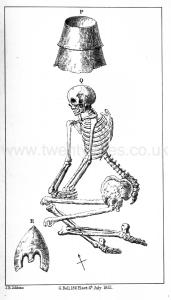
No. 15. This was a much larger and more elevated barrow, of the bowl shape, of about 3 feet in its elevation. It is not improbable that this had been before examined. We met with no regular cist or deposit, but fragments of rude pottery were plentiful; part of the bones of a human skull of remarkable thickness and development of the internal processes, two incisores teeth of a dog or fox, one tusk of a boar, and other teeth and bones in great variety; but in particular, a very beautiful and admirably chipped flint arrow-head (R). Having completed our investigation of these three barrows, we were invited by my good friend and a zealous Archæologist, Mr. Money Kyrle, the rector of Yatesbury, to proceed to his parish, where there were several barrows, said to be intact as yet. Whilst we were inspecting the Church, which, like Avebury, has of later times been converted in style to late decorated or perpendicular, but in which the south wall contains the piers and main arches of a Norman church, and the north aisle, at its west end, a very remarkable early English triplet window of very small size, and a very elegant and unique early English font, — the men were sent to commence operations on two mounds of large dimensions, but, judging from the irregularities of ground about them, of somewhat dubious character. In the mean time our attention was directed to the general and marked unevenness of surface in the fields of this parish—some of a peculiar character, as in one instance the appearance of a well in the centre of a considerable area formed by a mound of earth, in Cow Leaze—some at a part of the village called Town's-End— some near the house of Mr. Tenner—trenches more or less deep and important, with mounds in correspondence. It is not impossible that a detachment of forces, in their march previous to the battle of Roundaway Hill, near Devizes, may have halted here, and thrown up a hasty earthwork for their defence during the night, although the general unevenness in question cannot thus be accounted for. Let me here mention a little incident, which may possibly be useful in a similar way to future Archæologists. On seeing a blacksmith's shop near, I remarked that such an establishment should never be passed without a regard to the old iron and brass stores. On asking the principal Cyclops, (though I should beg his pardon, for he was father of the parish-clerk, one of our most strenuous coadjutors,) whether he ever had old spear-heads or such things brought to him with the old iron, he immediately admitted that he had many times, and thought he had somewhere one at that time, which, after a little search, was produced. It is of good workmanship, of the long four-sided shape. His son, hearing what was sought for, said there was another about the house, but it could not be found.

No. 16. This mound, situated near the house of Mr. Tuckey, to whom, as well as to his family, especially his eldest son, I am much indebted for repeated attention and assistance, did not produce any indications of former sepulture, except fragments of charcoal, and something like the oxidation of iron. It was composed of a close clayey soil, very different from the material of the barrows on the hills, as were all the four which we examined here; and this circumstance greatly added to the labour and time necessary for the investigation. We therefore proceeded to the second mound,—I so call them, because I much doubt if they were barrows. Here, from its size, and the top being crowned by a clump of fir-trees, the attack was made from the side by way of trench. Many bones, of the ox probably, and smaller animals, the hare in particular, one or two pieces of corroded iron, and a part of the wards of a key (S) were found; but no sepulchral deposit, although the trench was carried into the centre.
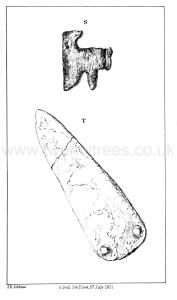
4th.—No. 17. Having obtained permission of the proprietor, Mr. Tenner, — who, notwithstanding a growing crop of beans, liberally sacrificed those which were likely to be in our way,—we proceeded at as early an hour as our party could reach the spot, to examine two barrows situated towards the eastern extremity of the parish, viz. in "Barrow Field," and with anticipations the most encouraging, as they were distinguished by traditions which ranked them highly in the estimation of the inhabitants1. They had been at least 20 ft. high; their bases were still of an extent to admit of such a proportionate height. Henry Shergold, the man who had been employed to lower them, being fortunately within reach, was sent for, and gave us the following account as to the first of the two which we examined, being that towards Avebury. He said, "He had cut it down a matter of 9 ft., throwing the earth on the sides, sixteen years ago. There was a little box of metal 3 inches long; it had a lid at one end, and a chain fixed in the middle, and it had been fastened to the end where it opened; it was round. About a yard deep, there were three beads (terra cotta, one was produced), as big as his finger round; a knife fit to stick a pig, and two skeletons lying at full length." At a depth of 8 ft. in this barrow, we came to a large quantity of very black substance, like charcoal, or rather burnt straw; numerous bits of bone of the various kinds, fragments of pottery, &c., and a large cist containing a considerable quantity of burnt human bones. The closeness of the soil of which these barrows were formed, and the depth to which we had to descend, occupied more than usually our time, and the evening was far spent before we had reached such a depth in the other barrow (No. 18) as to satisfy our curiosity; but the next day, on which we did not proceed to visit Yatesbury, in consequence of the lamented departure of my kind and valued companions, the men, under the superintendence of Mr. Money Kyrle, came to a layer of the black substance, burnt straw apparently, and below that to a most curious deposit, a cist, at the depth of 8 ft., formed at the level of the adjoining land, containing an unusual quantity of burnt human bones. These had been deposited in the hollow of a tree, and a piece of the cleft wood, the side of the tree, had been placed over it. From the peculiar clayey and damp quality of the earth, it was so greatly decayed, that it might be difficult to determine its former substance, although it appeared by the remains of fibres, and lines of the grain of the wood, to have been oak; the wood was 4 ft. long by broad and 18 inches thick, being reduced in places by compression. About the middle of this, on the apex of the mass of bones, and beneath the wooden cover, lay a bronze blade of a hunting-spear (T); the two rivets which had fixed it to its staff remained in their respective holes, but the metal, from the extreme moisture of the situation, had become oxidised through out, and when dried extremely brittle and friable; it was 4½ inches in length, and 1½ inch in breadth at the broadest part.
Note 1. A few hundred yards to the south-east of these barrows, in a field called Foxbury, the termination of which word would denote the existence of some earthwork which has disappeared before the plough, various Koman coins, from Trajan to Valens, have recently been found.

04 Aug 1849. Saturday, the 4th of August, was in the morning chiefly devoted to Silbury [Map]; and it was arranged that I should be left in charge, as the examination of the centre was every hour becoming more and more critical and interesting. After due consultation respecting Silbury, our steps were directed to a singularly interesting object, described as an Archdruid's barrow [West Kennet long barrow [Map]], lying three quarters of a mile south-east of Silbury Hill [Map]. This appellation I suppose has been adopted from Stukeley; it ranges about east and west, and is at least 150 ft. long, higher and broader at the east end, where it is 30 ft., than at the west. It had evidently been cut through on the ridge in several places, but not improbably, in most instances, merely for agricultural purposes. At the east end were lying, in a dislodged condition, at least 30 sarsen stones, in which might clearly be traced the chamber formed by the side uprights and large transom stones, and the similar but lower and smaller passage leading to it; and below, round the base of the east end, wre to be seen the portion of the circle or semicircle of stones bounding it. There are two other barrows of this kind in the neighbourhood, which I may mention in this place; the one [East Kennet Long Barrow [Map]] about three-quarters of a mile south-east of that just described, which is of much the same character as to shape and dimensions, but differs in construction. I was induced to visit this in consequence of having been informed by the occupier of the surrounding land, that he had caused a hole to be dug at the east end for the purpose of obtaining flints; but that he soon found that it was made up of round and generally flat sarsen stones, which came tumbling so about the men that they gave up the work. It has unfortunately been planted over, as have many of the larger barrows on Hacpen Hill; I think in bad taste. The other is situated on Alton Down [Adam's Grave [Map]?], south of Wansdyke: all these range in the same bearing, south-east by north-west. It is 130 ft. long by 30 high. This is still covered with turf, and has been opened about half-way along the ridge, but not effectually. It is remarkable for having, about half-way down the slope of the east end, a sarsen stone; another at the base in the centre. On the south side, in the trench formed by raising the mound, is a very curious earthwork, in form an oval, with a mound about 2 ft. high round it, and a sarsen stone in the centre; the whole about 40 feet long by 15 broad. In advance of the barrow eastward, and at its very base, is another earthwork, of similar height as to its mound, in a line at right angles with the central line, about 30 ft. long, with a return of 10 ft. on either side. These two curious objects I visited at so late a period of my Wiltshire sojourn, that I could not indulge in the gratification of examining them. It is a satisfaction to mention these three, in the hope that it may lead to the disclosure of their interesting contents at some future day.
The time had now arrived for the breaking up of our happy party; I think I may say with certainty, that there was not one to whom the well-known words of the Grecian bard might not be applied—
[Greek lettering here]
What could I, the lone and deserted, do, hut seek those wilds and desolate hills where not a human footstep would cross my path, and betake myself to regions so emblematic, and congenial to my solitary state ? It had been repeatedly asserted that most of the curious relics which had accidently been discovered, were found on the hills south of Beckhampton and Kennett, and some of these I shall hope to be able to figure and describe. On this doleful evening, then, I strolled in that direction, purposing after such a reconnoitre to devote a day to the examination of such barrows as might appear promising. For the present, I shall confine myself to the mere allusion to some very remarkable earthworks which met my view, and shall reserve the description of them and the barrows in this district for the subsequent day, on which they were opened.
07 Aug 1849. 7th. —The next investigation which occupied my attention was on Minnow Down, at the summit of a rising ground near "the Pennings," very possibly an ancient meadow for cattle, belonging to Mr. Brown, at the edge of which is a very large barrow, which has from time to time been reduced for agricultural purposes, and produced several curious British remains.
No. 19 . This very small and slightly elevated barrow, without a trench, had attracted my observation on my way to examine more accurately the remains of the tree in the Yatesbury barrow; its appearance and isolated situation seemed to bespeak success. It was not, however, of the class to which, on an outward view, it would have been assigned. Near the centre, and at about the level of the surrounding down, was a shallow cist, containing black earth and a very few burnt bones. Near the top were two small pieces of good Samian ware. The Roman road runs at no great distance to the south. There were but few pieces of pottery of the British or Romano-British character, a few broken bones of animals, and parts of the jaw of a red deer. The weather on this day was very unfavourable; and at night,—much to the satisfaction, I have no doubt, of the rustics, whose notions respecting the examination of Silbury and the opening of the barrows were not divested of superstitious dread,—one of the most grand and tremendous thunder-storms I ever recollect to have witnessed, made the hills re-echo to the crashing peals, and Silbury itself, as the men asserted who were working in its centre, to tremble to its base,—although they could not see the flashes of violet-coloured lightning which lit up the broad expanse of hills, and defined their outline in their most distant range.
The next morning broke in calmness and brightness, and was devoted to my explorations on the southern side of the river Kennett, and under the line of Wansdyke, which runs at this point nearly parallel to it. In the four barrows (Nos. 20, 2J, 22, 23) which were opened in this direction, nothing worthy of particular notice was found. Apparently their situations, single and of low dimensions, led to the supposition that they were of early date, and would produce interesting evidence of their class. Two of them contained cists, with burnt bones, fragments of rude unbaked pottery, and bones of animals. Whether their contiguity to the boundary of another and more powerful race may account for the poverty of these burial-places and their tenants when living, I pretend not to say; but there are other features in this immediate district which do not accord altogether with such a supposition—I mean, their earthworks, which are here well worthy of note, and to which I have already alluded.
It is difficult to describe such remains without the aid of diagrams, and I must therefore refer to such as I can supply as we proceed.
I. Is an irregular parallelogram, containing three or four compartments, lying on the side of the hill gently sloping downwards towards the north. The south side is bounded by a well-defined mound, with a slight trench, about 100 feet in length. About half-way, running at right angles, is a mound which expands into an irregular heap of earth of some height, and joined at its southern extremity, at about 40 feet, by another mound at right angles with the first. On the west side are some irregular entrenchments, with a circular mound at the corner, affording apparently the entrance to this enclosure. On the east side the mound runs, for about 100 feet, in a line at right angles with the south, and is there curved, till it becomes parallel to the south boundary, for about 40 feet, when it forms again a right angle northward with another curve, and continuation of the parallel line to the south boundary, till it reaches the angle of the eastern mound. At the corner formed by the intersection of the south and west mounds was a conical mound, in which were three large sarsen stones; these were removed, and the earth below excavated, which was of dark colour and extending deeper than usual, but nothing was contained in it except a few fragments of bones of the ox or deer. In the compartment adjacent to these was a circular conical hole 10 feet in diameter, 5 or 6 deep. Diagonally, in the next compartment, were ranged three barrows; that towards the north-west contained nothing excepting a few small bits of pottery, charcoal, and bones. The next much the same. The third, which was of large dimensions, had been excavated at the apex to some depth; and concluding that this had been done by an antiquary, I did not deem it prudent to interfere with his work. I had, however, the mortification to learn in the evening, from a shepherd-boy, "that his father had dug that 'un out for shelter." To all appearance he must have gone deep enough to have disturbed any deposit that might have been there.

II. Is higher up on the next hill (the slope of Tan Hill), and a short distance below Wansdyke. It is a square enclosure, 200 feet each side, formed by a mound of earth, 4 feet high, and having a circular mound (as a barrow) at each corner. On the south side there was an entrance equidistant from each corner; and on the east side part of the mound has been cut away.

III. At about a mile and a half south of Kennett is another singular earthwork. It is formed by a mound of earth about 3 feet high, and about 200 feet long by 40 broad. This runs across the valley where it is situated, and rises on one side half as high again as on the other. At about one-third of the distance from the upper end is an oval enclosure, having a mound of slight elevation round it, the area being slightly convex.

IV. At a short distance from the former, on a neighbouring hill, is another earthwork of very remarkable character. It stands south from Silbury Hill, distant about a mile on the west side of the old Andover road, evidently a British trackway. From its north-east extremity, D, a vallum extends about half a mile along the ridge of the down, which has been rendered more precipitous to form the same. It points towards Silbury, and seems to connect that mound with the earthwork. On the south and east sides the fosse bounding the earthwork follows the natural curve of the hill; on the west side, where it is straight and runs up the hill, the vallum gradually diminishes in height. The peculiar formation of the north side, the entrance at the north-west angle, and the curious detached and square enclosure, will be best understood from the ground-plan.

V. The next is not in this district, nor on the same side of the Kennett, but may as well be mentioned with others of a similar character. It is situated at the foot of a portion of the Hacpen Hill, in a cwm which it forms to the south of the Avebury Down. It is formed by straight lines of mounds, at right angles, ? feet high, 100 paces long on the south side, and about 80 broad. Parallel with the eastern side, at about a third of the area, is another mound and trench running from the north side to within 10 feet of the south mound, where it returns at right angles for about 40 paces, where it again turns at right angles towards the north for ?0 paces, where it meets at right angles a similar mound ranging from the west side to that described as running parallel with the eastern boundary; parallel with this, for about 80 paces and at 8 distant, is another mound extended so as to form the entrance. Immediately above, i, e, to the south of this, the interior compartment is excavated to some depth; and above it and beyond the exterior mound is a recess cut in the slope of the hill, returned at each end, with a mound towards the south about 80 paces long. These embankments were opened in several spots, but nothing found to indicate that palisades had been raised on them.

Before I leave the southern district, I must record, for the guidance of brother Archæologists, the existence on this side of the Kennett, as well as on the north, of millions of sarsen stones scattered in the valleys, and in some instances indicating arrangement in their disposition; thus in a valley running from Tan Hill south-west and north-east there are rows of large stones standing up unusually 3 or 4 feet out of the ground, and of large dimensions. A little more to the south in the same valley is the evident remnant of a kistvaen; the larger chamber traceable, as well as the passage once leading into it. And again, on the top of the hill to the south-east is another evidently of the same kind. These, from hollows formed by their peculiar construction, present a well-known asylum for coursed hares; and if inquired for as the Hares' Holes, any of the neighbouring rustics would doubtless afford unerring direction to them.
10 Aug 1749. 10th - Return we now to our former ground, where our examinations were concluded in the following days with singular success. It. had been thought that some of the barrows on Windmill Hill which the plough had worn down might be worth examination, and two not having crops upon them were tried, but without producing any thing more than bones of animals, fragments of pottery and burnt wood; the second, burnt wood in considerable quantity. I therefore resolved to pass on to the Avebury Down, where we had left two of the range of five unexplored, and these were the next operated upon, as we have already reported of Nos. 2 and 3. Whilst the excavation of these was in its early progress, I had directed my eye to the more distant range of the hill on the north-east; and near the foot of it, on Monkton Down, attention was soon arrested by very remarkable and unquestionable indications of British occupation. Commencing from the cultivated land at the foot of the hill, we observed, in a central position, a somewhat long mound of considerable elevation. On the right and left of this, at some ten paces each way, were two lower circular but not regular mounds. Above the long mound, with 6 or 8 feet intervening, was a large mound of an oval form, the upper portion being the smallest part, and on the top of this were three large sarsen stones. Above this, at some 50 yards and at considerable elevation, the hill had been formed into a flat cone (a road passing on two sides), with a single trench and slight mound surrounding it, in diameter 25 feet. Towards the centre of this were disposed four sarsen stones of considerable size. At the verge of the lowest long mound, towards the north-west, were eight sarsen stones of about 2 feet square above the ground, forming the segment of a circle, the two horns of which were lost in the mound, and these had been brought to light by the cultivation of the land below. At the same level, about 8 feet within the mound, was a large flat sarsen placed on its edge, and forming with two others part of an interior circle, or segment. At the verge of the oval mound above, and cutting its range, were, on the south side, five large sarsen stones, and on the opposite or northern side one, evidently the remains of a larger circle of stones, containing, but not concentrically, those already noticed. This curious arrangement must be explained with the aid of a ground-plan.
No. 24a [Map]. In the small mound on the north side were teeth of deer, oxen, and bones, small fragments of charred wood, and a small sarsen stone partially rubbed.
No. 25b In the opposite mound were similar remains, and in very considerable quantities; and in this was a sarsen (U) 3 inches in diameter rubbed down to a cylindrical form, and the front teeth of an ox.
No. 26c - Five different openings had been made in this long mound, which were afterwards conjoined, and formed one continuous cutting throughout. At 7 was a large half of the os frontis of an ox, and some fragments of horns of deer, one small tip of an ox's horn.
Note d. Here, at about a foot from the surface, was found the head of apparently a greyhound (V), and close by the side a fragment of a small ampulla of Koman form, but somewhat coarse pottery; below was a flat sarsen (W) rounded at the edge and slightly convex.
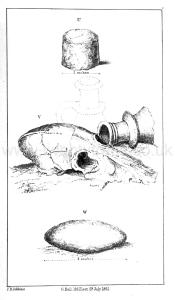
No. 27e. In the repeated examinations made in the upper mound within the circle and under the sarsens, ox and deer's bones and teeth, sarsens of considerable size, and boars' tusks were found. The excavations both in this part and in the long mound had been very extensive, and it must be confessed had resulted in something like disappointment, from the promise their appearance had held out. To Mr. Hillier, the occupier of this district, and his lady, who regaled us and a large party with a substantial tea repast, we were indebted for a most agreeable and acceptable mode of consolation, and the grand success of our efforts is yet to be related in the contents of the oval mound.
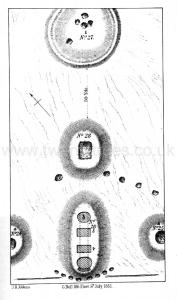
No. 28 [Map]. On removing the three sarsen stones from the apex, about a foot deep, appeared the fragments of a small ornamental urn (X) of unbaked and very fragile clay, containing the skull-bones principally of a very young person, the sutures not being joined or knit; near the top was a sarsen, rounded, and about 2 inches in diameter. The material of which this barrow was composed was chalk rubble, very coarse, and not mixed with other substances, as was generally the case, nor were there fragments of bones, or urns, or pottery, as observed in others. At the depth of 5 feet were (Y) the heads of two oxen laid side by side, and in very perfect condition, but very brittle on removal; from the pole to the nose-bone one measured 20 inches, the other 19; from one orbit of the eye to the other 9 inches; in each the centre of the forehead had been fractured in a circular hole. Below these the same hollow character of the chalk continued, and the sides of the chamber, 6 feet in length by 4 feet in breadth, had been carefully cut in the natural chalk. The heads of the oxen were laid across the chamber north-east. At a depth of 5 feet below these, and 10 feet from the top, was the skeleton of an adult (Z), in many parts much decayed, but in the crouched position, lying on the left side; behind the head was a small ornamented urn of unbaked clay (aa) or at least only fire-baked, and not in a kiln; the thigh-bone was 19 inches in length; at the right foot was a small well-chipped flint arrow-head (bb) and a flint spear-head (cc). A second also was subsequently found near the same spot (dd),though not so well formed.
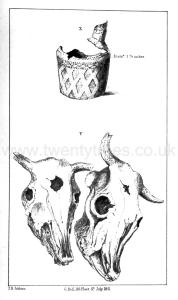


The whole of this group of mounds presented a singularly interesting character. I cannot say that I should be fully satisfied that we had exhausted the stores of the long and two lateral mounds, unless the range of sarsens could have been fully developed, and the natural chalk as above pertinaciously pierced; although, at the time, it seemed to Mr. Money Kyrle, as well as to myself, that we had exhausted every hope.
No. 29 . On the brow of the hill towards the east from this spot, and overlooking one of those surprising valleys of stones, in which might he traced long lines of sarsens arranged for some special purpose, whilst others are huddled together as if they had fallen in such a confused heap, is a circle, 16 feet in diameter (ee), of sarsen stones, of which seven only now remain, although the dips in the earth shew where the others have been. In the centre of these are five of the same character and size, surrounding one lying flat and impacted between them. The first thing which shewed itself on raising this central stone was a fragment of red Samian pottery; it is true it might have slipped down between the stones at a date long subsequent to the formation of these circles; it is certain that it was of a very different character from the other rude but curious relics below. These consisted of numerous fragments of the rudest and thickest kind of pottery, with bones of the deer or ox, bits of charcoal, and some portions of a yellowish-tinged ochre-looking substance; but lower down, and near the natural layer of the chalk, were numerous pieces of flint of about li inch across, evidently chipped into form, as if to he held in the hand or fastened to some handle. There were also many small pieces of flint, apparently chipped on purpose into thin laminae, intended perhaps for arrow-heads, and either never finished or possibly spoilt in the difficult and tedious manipulation.
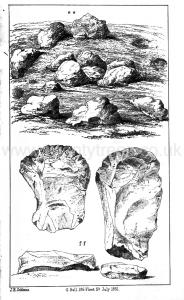
14th.—One day only remained to me for these interesting pursuits. The barrow described as No. 9 was one of this day's investigation; another was contained within the range of a circle of stones (gg) of about 9 feet in diameter, of which eight stones (No. 30) only remained, but hollows in the turf indicated the positions which four others had occupied, and they were known to have been removed for building purposes. A large quantity of fragments of rude pottery, of bones of animals, bits of charcoal, teeth of deer, oxen, and swine, were all that this produced; and it is not improbable that it had been before explored, being a short distance on the north of the five barrows on the Avebury Down. On the summit of the hill, overlooking towards the south-east the Cromlech at Clatford, towards the east Temple Down, and the south-west and west the Hacpen range, studded with an immense number of very large sarsen stones, many of which indicated arrangement of lines and segments of circles, there are two spots which, in particular, challenge attention. The one from the congeries of very large stones lying on and about each other, as if they had so fallen from some different and probably more elevated position; the other from its conical formation of earth and most commanding position, and being surrounded with sarsen stones in circular arrangement. This was opened to some depth, but time did not then suffice to descend so far as to reach the maiden soil or chalk, or to satisfy us that nothing more was to be obtained but the circular and flat sarsen stones of about a foot diameter, not broken, but worn like pebbles, which abounded, together with the fragments of charcoal, bones, pottery, and teeth.
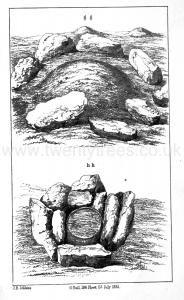
No. 31. Returning towards the north-west, a small flat barrow (hh) without a trench was the object of our curiosity, which, although it was situated on the very side of a road, did not disappoint us. At a depth of 18 inches we came to five thin sarsen stones of a foot or 16 inches broad or long, set upon their edges, and within them four other stones of the same kind, but larger and naturally rounded, by which an urn containing burnt human bones was packed. In the centre of this cist, 2 feet 2 by 10 inches, the urn, as well as the stones, had been placed on a flat stone below— the former with its mouth downwards; it was of rude formation, of the character of that found in No. 4, and about the same shape; the upper part, 10 inches in diameter, above the rim being cross-etched. Nearly all below the rim, from its proximity to the surface, had long since been crushed and reduced to earth.
"Hic labor extremus, longarum hsec meta viarum." [This is the final effort, this is the end of a long journey]

It is no affectation to say that I left on the following day this peculiar but most interesting neighbourhood with great regret, and not least of all those very many and kind friends to whom I was so much indebted for the facilities of exploring the barrows, and who favoured me with so many marks of their consideration and most thoughtful kindness. They are too many to specify by name; but I trust I may be allowed to assure them all that the recollection of them and the pleasure they studied to afford me will never cease to command my most grateful and pleasurable appreciation.
J. M.
Wiltshire Archaeological Magazine 1907 V35 Pages 1-20. Previous to this discovery there seem to have been only six recorded finds of Grape Cups1. They were so named by Sir R. Colt Hoare, and re-named "nodulated cups" by Dr. Thurnam2, who included among their number a small rude cup, now in the Museum at Devizes3, which though nodulated, can by no stretch of the imagination be classed as a Grape Cup. Four of these cups are in the Museum at Devizes, one is in the Bristol Museum, and one has been lost sight of. With the exception of the one at Bristol that was found in a barrow at Priddy, in the neighbouring county of Somerset, they have all been found in Wiltshire barrows.
Upton Lovel Golden Barrow, with burnt interment. Ancient Wilts, p. 99, at Devizes; Amesbury, barrow 133, burnt, ibid, p. 199, at Devizes; Normanton, barrow 156, unburnt, ibid, p. 202, at Devizes. Barrow on Windmill Hill, near Avebury, see Rev. A. C. Smith's Map, Section VI., F. IV.b., unburnt interment; Arch. Instit., Salisbury, p. 108. at Devizes. Barrow south-east of Kennet, unburnt interment, LOST. Diary of a Dean, p. 44 [02 Aug], fig. 2. Barrow near Priddy, burnt interment, at Bristol Museum, Arch. Journ., XVI., p. 149. Of the seven grape cups now known it will be seen that three were with burnt and four with unburnt burials.
Note 2. Archœologia, XLIII., p. 364.
Note 3. Stourhead Cat., No. 187.